FIAT 500 2018 Owner handbook (in English)
Manufacturer: FIAT, Model Year: 2018, Model line: 500, Model: FIAT 500 2018Pages: 224, PDF Size: 3.89 MB
Page 161 of 224
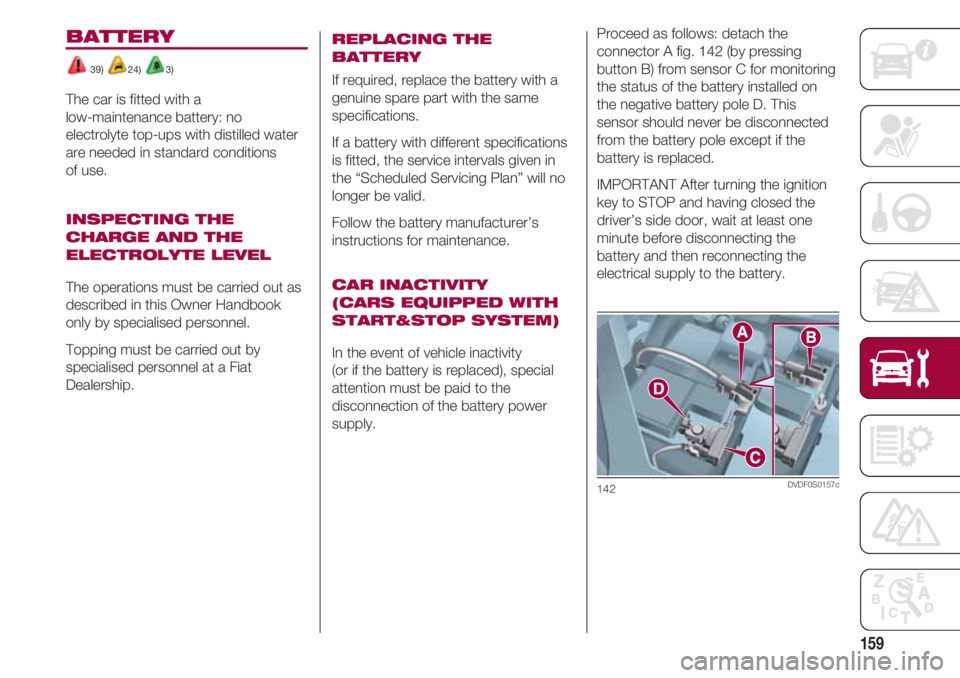
159
Proceed as follows: detach the
connector A fig. 142 (by pressing
button B) from sensor C for monitoring
the status of the battery installed on
the negative battery pole D. This
sensor should never be disconnected
from the battery pole except if the
battery is replaced.
IMPORTANT After turning the ignition
key to STOP and having closed the
driver’s side door, wait at least one
minute before disconnecting the
battery and then reconnecting the
electrical supply to the battery.
142DVDF0S0157c
BATTERY
39) 24) 3)
The car is fitted with a
low-maintenance battery: no
electrolyte top-ups with distilled water
are needed in standard conditions
of use.
INSPECTING THE
CHARGE AND THE
ELECTROLYTE LEVEL
The operations must be carried out as
described in this Owner Handbook
only by specialised personnel.
Topping must be carried out by
specialised personnel at a Fiat
Dealership.
REPLACING THE
BATTERY
If required, replace the battery with a
genuine spare part with the same
specifications.
If a battery with different specifications
is fitted, the service intervals given in
the “Scheduled Servicing Plan” will no
longer be valid.
Follow the battery manufacturer’s
instructions for maintenance.
CAR INACTIVITY
(CARS EQUIPPED WITH
START&STOP SYSTEM)
In the event of vehicle inactivity
(or if the battery is replaced), special
attention must be paid to the
disconnection of the battery power
supply.
Page 162 of 224
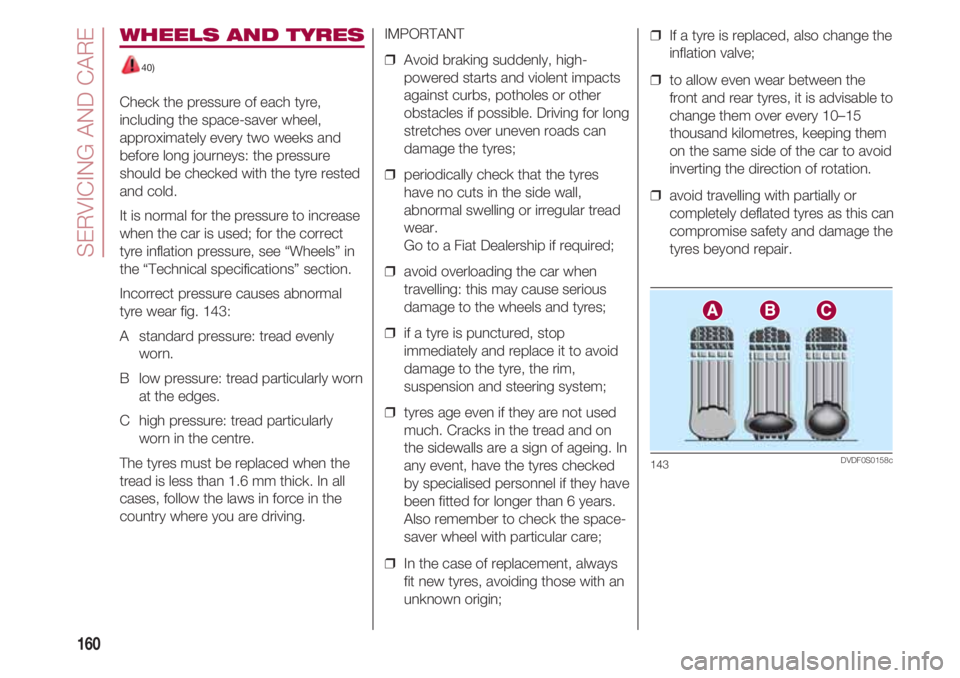
SERVICING AND CARE
160
WHEELS AND TYRES
40)
Check the pressure of each tyre,
including the space-saver wheel,
approximately every two weeks and
before long journeys: the pressure
should be checked with the tyre rested
and cold.
It is normal for the pressure to increase
when the car is used; for the correct
tyre inflation pressure, see “Wheels” in
the “Technical specifications” section.
Incorrect pressure causes abnormal
tyre wear fig. 143:
A standard pressure: tread evenly
worn.
B low pressure: tread particularly worn
at the edges.
C high pressure: tread particularly
worn in the centre.
The tyres must be replaced when the
tread is less than 1.6 mm thick. In all
cases, follow the laws in force in the
country where you are driving.
IMPORTANT
❒ Avoid braking suddenly, high-
powered starts and violent impacts
against curbs, potholes or other
obstacles if possible. Driving for long
stretches over uneven roads can
damage the tyres;
❒ periodically check that the tyres
have no cuts in the side wall,
abnormal swelling or irregular tread
wear.
Go to a Fiat Dealership if required;
❒ avoid overloading the car when
travelling: this may cause serious
damage to the wheels and tyres;
❒ if a tyre is punctured, stop
immediately and replace it to avoid
damage to the tyre, the rim,
suspension and steering system;
❒ tyres age even if they are not used
much. Cracks in the tread and on
the sidewalls are a sign of ageing. In
any event, have the tyres checked
by specialised personnel if they have
been fitted for longer than 6 years.
Also remember to check the space-
saver wheel with particular care;
❒ In the case of replacement, always
fit new tyres, avoiding those with an
unknown origin;❒ If a tyre is replaced, also change the
inflation valve;
❒ to allow even wear between the
front and rear tyres, it is advisable to
change them over every 10–15
thousand kilometres, keeping them
on the same side of the car to avoid
inverting the direction of rotation.
❒ avoid travelling with partially or
completely deflated tyres as this can
compromise safety and damage the
tyres beyond repair.
143DVDF0S0158c
Page 163 of 224
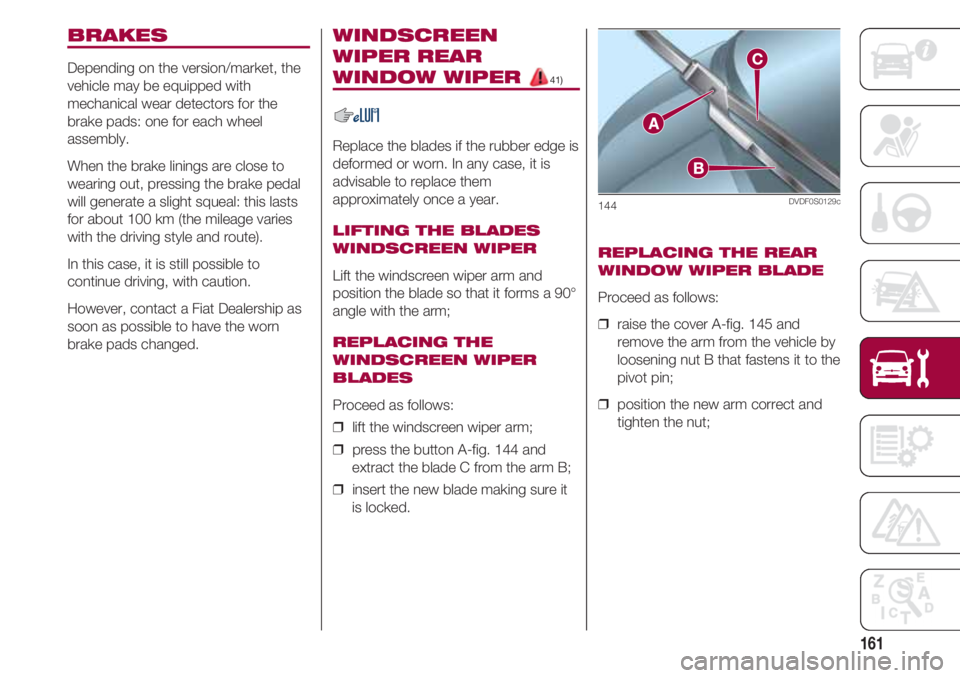
161
BRAKES
Depending on the version/market, the
vehicle may be equipped with
mechanical wear detectors for the
brake pads: one for each wheel
assembly.
When the brake linings are close to
wearing out, pressing the brake pedal
will generate a slight squeal: this lasts
for about 100 km (the mileage varies
with the driving style and route).
In this case, it is still possible to
continue driving, with caution.
However, contact a Fiat Dealership as
soon as possible to have the worn
brake pads changed.
WINDSCREEN
WIPER REAR
WINDOW WIPER 41)
Replace the blades if the rubber edge is
deformed or worn. In any case, it is
advisable to replace them
approximately once a year.
LIFTING THE BLADES
WINDSCREEN WIPER
Lift the windscreen wiper arm and
position the blade so that it forms a 90°
angle with the arm;
REPLACING THE
WINDSCREEN WIPER
BLADES
Proceed as follows:
❒ lift the windscreen wiper arm;
❒ press the button A-fig. 144 and
extract the blade C from the arm B;
❒ insert the new blade making sure it
is locked.
REPLACING THE REAR
WINDOW WIPER BLADE
Proceed as follows:
❒ raise the cover A-fig. 145 and
remove the arm from the vehicle by
loosening nut B that fastens it to the
pivot pin;
❒ position the new arm correct and
tighten the nut;
144DVDF0S0129c
Page 164 of 224
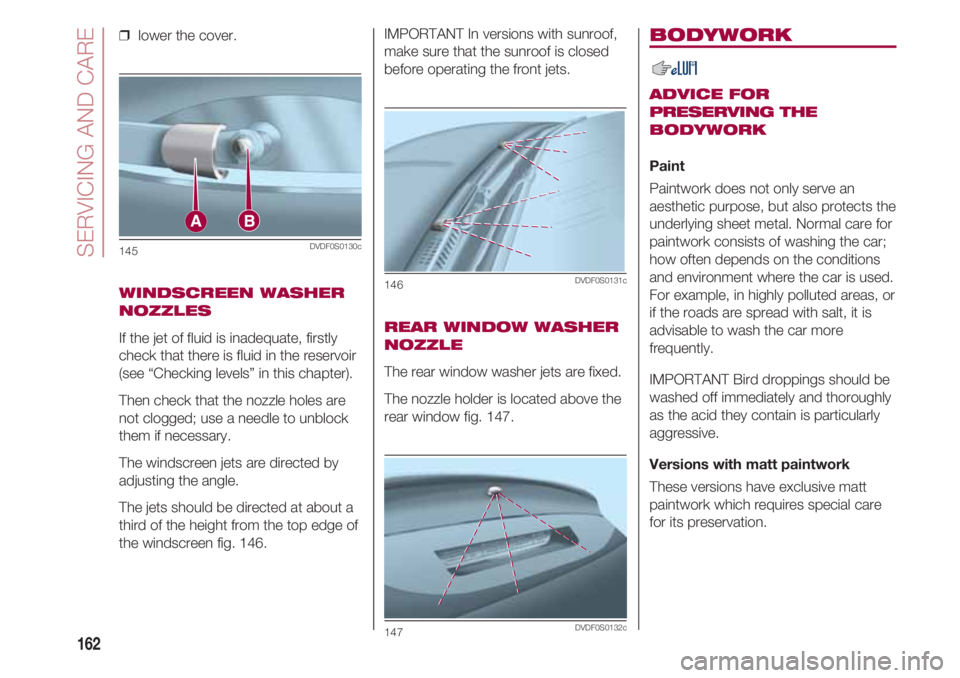
SERVICING AND CARE
162
❒ lower the cover.
WINDSCREEN WASHER
NOZZLES
If the jet of fluid is inadequate, firstly
check that there is fluid in the reservoir
(see “Checking levels” in this chapter).
Then check that the nozzle holes are
not clogged; use a needle to unblock
them if necessary.
The windscreen jets are directed by
adjusting the angle.
The jets should be directed at about a
third of the height from the top edge of
the windscreen fig. 146.
145DVDF0S0130c
IMPORTANT In versions with sunroof,
make sure that the sunroof is closed
before operating the front jets.
REAR WINDOW WASHER
NOZZLE
The rear window washer jets are fixed.
The nozzle holder is located above the
rear window fig. 147.
146DVDF0S0131c
147DVDF0S0132c
BODYWORK
ADVICE FOR
PRESERVING THE
BODYWORK
Paint
Paintwork does not only serve an
aesthetic purpose, but also protects the
underlying sheet metal. Normal care for
paintwork consists of washing the car;
how often depends on the conditions
and environment where the car is used.
For example, in highly polluted areas, or
if the roads are spread with salt, it is
advisable to wash the car more
frequently.
IMPORTANT Bird droppings should be
washed off immediately and thoroughly
as the acid they contain is particularly
aggressive.
Versions with matt paintwork
These versions have exclusive matt
paintwork which requires special care
for its preservation.
Page 165 of 224

163
The instructions for good preservation
follow below:
❒ avoid washing with rollers and/or
brushes in washing stations.
Then, wash the vehicle, only by
hand, using pH-neutral detergents;
dry it with a wet chamois leather.
Abrasive products and/or polishes
should not be used for cleaning the
vehicle.
❒ Bird droppings must be washed off
immediately and thoroughly as the
acid they contain is particularly
aggressive.
❒ Avoid (if at all possible) parking the
vehicle under trees; remove
vegetable resins immediately as,
when dried, it may only be possible
to remove them with abrasive
products and/or polishes, which is
highly inadvisable as they could alter
the typical opacity of the paint.
❒ Do not use pure windscreen washer
fluid for cleaning the front
windscreen and rear screen; dilute it
by at least 50% in water.
Some versions are fitted with exclusive
decorations on the door mirror covers;
do not use pressurised or high-
temperature jets of water when washing
them.Versions with stickers or wrapping
4)
To correctly clean and wash the car,
proceed as follows:
❒ Avoid washing with rollers and/or
brushes in washing stations.
Then, wash the vehicle, only by
hand, using pH-neutral detergents;
dry it with a wet chamois leather.
Abrasive products and/or polishes
should not be used for cleaning the
vehicle.
❒ If high pressure jets or cleaners are
used to wash the vehicle, hold at
least 40 cm away from the
bodywork to avoid damage or
alteration. It should be remembered
that the build up of water can
damage the car over a period of
time;
❒ Wash the bodywork using a low
pressure jet of water;
❒ Use a sponge to wipe a slightly
soapy solution over the bodywork,
frequently rinsing the sponge;
❒ Rinse with plenty of water and dry
with a jet of air or a chamois leather.
Dry the less visible parts with special
care, such as the door frames,
bonnet and the headlight frames,
where water may stagnate more
easily. The car should not be taken
to a closed area immediately, but
left outside so that residual water
can evaporate.
Do not wash the car after it has been
parked in the sun.
Exterior plastic parts must be cleaned
in the same way as the rest of the
vehicle.
Where possible, do not park under
trees; the resinous substances that
many species release give the paint a
dull appearance and increase the
possibility of triggering rusting
processes.
IMPORTANT Bird droppings must be
washed off immediately and thoroughly
as the acid they contain is particularly
aggressive.
Page 166 of 224
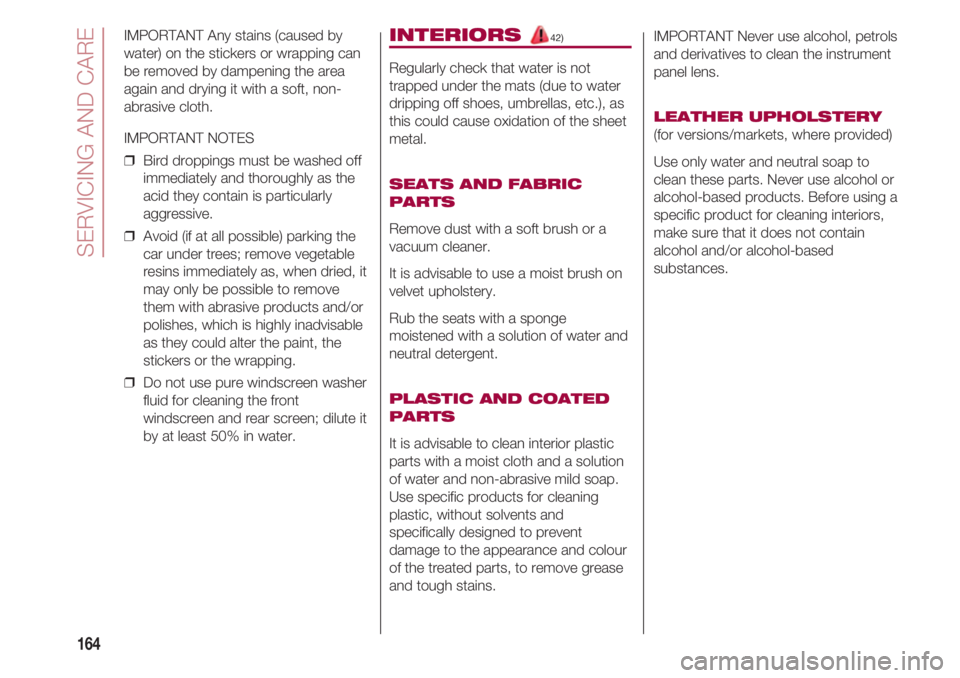
SERVICING AND CARE
164
IMPORTANT Any stains (caused by
water) on the stickers or wrapping can
be removed by dampening the area
again and drying it with a soft, non-
abrasive cloth.
IMPORTANT NOTES
❒ Bird droppings must be washed off
immediately and thoroughly as the
acid they contain is particularly
aggressive.
❒ Avoid (if at all possible) parking the
car under trees; remove vegetable
resins immediately as, when dried, it
may only be possible to remove
them with abrasive products and/or
polishes, which is highly inadvisable
as they could alter the paint, the
stickers or the wrapping.
❒ Do not use pure windscreen washer
fluid for cleaning the front
windscreen and rear screen; dilute it
by at least 50% in water.INTERIORS 42)
Regularly check that water is not
trapped under the mats (due to water
dripping off shoes, umbrellas, etc.), as
this could cause oxidation of the sheet
metal.
SEATS AND FABRIC
PARTS
Remove dust with a soft brush or a
vacuum cleaner.
It is advisable to use a moist brush on
velvet upholstery.
Rub the seats with a sponge
moistened with a solution of water and
neutral detergent.
PLASTIC AND COATED
PARTS
It is advisable to clean interior plastic
parts with a moist cloth and a solution
of water and non-abrasive mild soap.
Use specific products for cleaning
plastic, without solvents and
specifically designed to prevent
damage to the appearance and colour
of the treated parts, to remove grease
and tough stains.
IMPORTANT Never use alcohol, petrols
and derivatives to clean the instrument
panel lens.
LEATHER UPHOLSTERY
(for versions/markets, where provided)
Use only water and neutral soap to
clean these parts. Never use alcohol or
alcohol-based products. Before using a
specific product for cleaning interiors,
make sure that it does not contain
alcohol and/or alcohol-based
substances.
Page 167 of 224
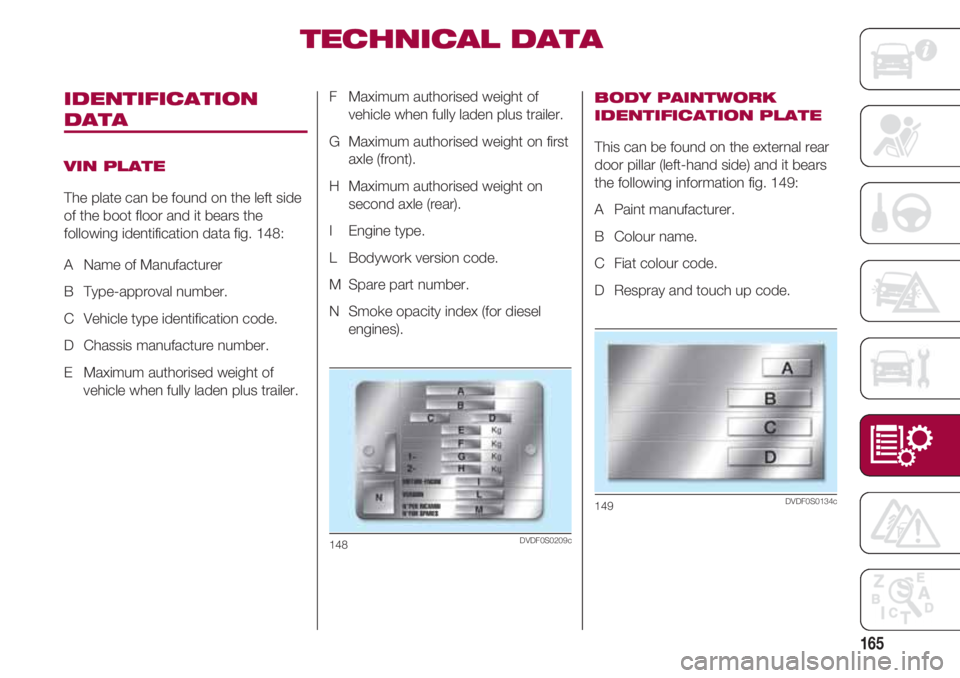
165
TECHNICAL DATA
IDENTIFICATION
DATA
VIN PLATE
The plate can be found on the left side
of the boot floor and it bears the
following identification data fig. 148:
A Name of Manufacturer
B Type-approval number.
C Vehicle type identification code.
D Chassis manufacture number.
E Maximum authorised weight of
vehicle when fully laden plus trailer.F Maximum authorised weight of
vehicle when fully laden plus trailer.
G Maximum authorised weight on first
axle (front).
H Maximum authorised weight on
second axle (rear).
I Engine type.
L Bodywork version code.
M Spare part number.
N Smoke opacity index (for diesel
engines).
148DVDF0S0209c
BODY PAINTWORK
IDENTIFICATION PLATE
This can be found on the external rear
door pillar (left-hand side) and it bears
the following information fig. 149:
A Paint manufacturer.
B Colour name.
C Fiat colour code.
D Respray and touch up code.
149DVDF0S0134c
Page 168 of 224
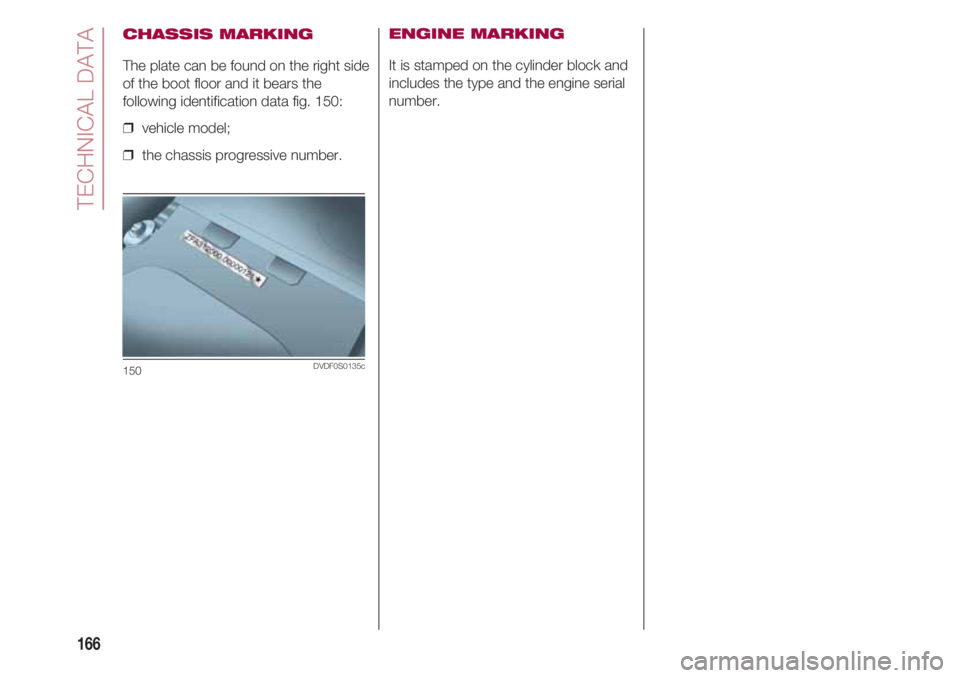
TECHNICAL DATA
166
CHASSIS MARKING
The plate can be found on the right side
of the boot floor and it bears the
following identification data fig. 150:
❒ vehicle model;
❒ the chassis progressive number.
150DVDF0S0135c
ENGINE MARKING
It is stamped on the cylinder block and
includes the type and the engine serial
number.
Page 169 of 224
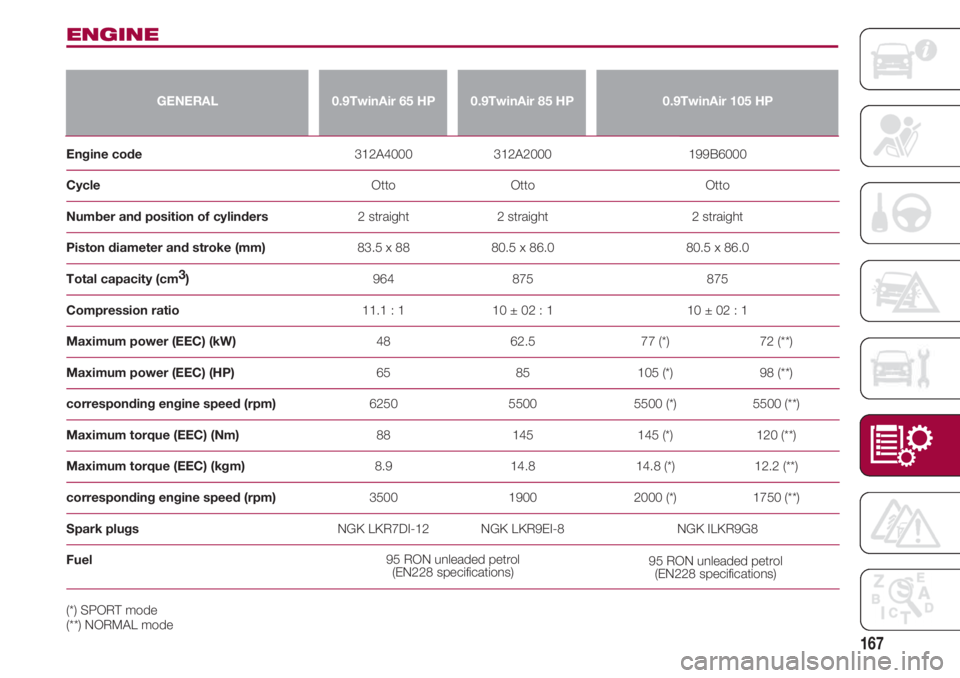
167
ENGINE
GENERAL0.9TwinAir 65 HP0.9TwinAir 85 HP0.9TwinAir 105 HP
Engine code 312A4000 312A2000 199B6000
Cycle Otto Otto Otto
Number and position of cylinders 2 straight 2 straight 2 straight
Piston diameter and stroke (mm) 83.5 x 88 80.5 x 86.0 80.5 x 86.0
Total capacity (cm3
) 964 875 875
Compression ratio 11.1 : 1 10 ± 02 : 1 10 ± 02 : 1
Maximum power (EEC) (kW) 48 62.5 77 (*) 72 (**)
Maximum power (EEC) (HP) 65 85 105 (*) 98 (**)
corresponding engine speed (rpm) 6250 5500 5500 (*) 5500 (**)
Maximum torque (EEC) (Nm) 88 145 145 (*) 120 (**)
Maximum torque (EEC) (kgm) 8.9 14.8 14.8 (*) 12.2 (**)
corresponding engine speed (rpm) 3500 1900 2000 (*) 1750 (**)
Spark plugs NGK LKR7DI-12 NGK LKR9EI-8 NGK ILKR9G8
Fuel
95 RON unleaded petrol
(EN228 specifications)95 RON unleaded petrol
(EN228 specifications)
(*) SPORT mode
(**) NORMAL mode
Page 170 of 224
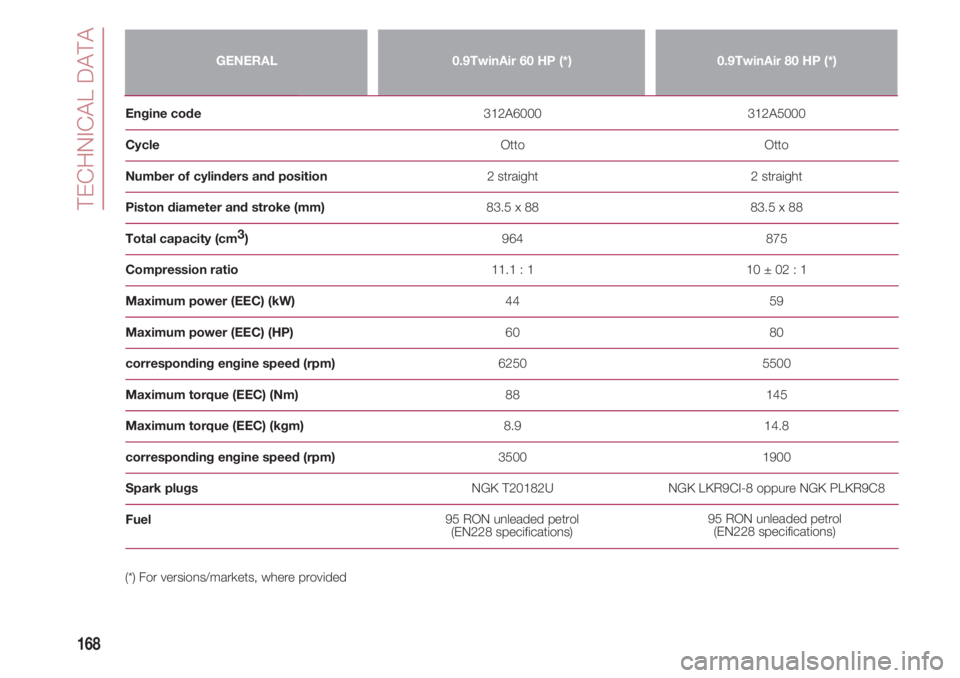
TECHNICAL DATA
168
GENERAL0.9TwinAir 60 HP (*)0.9TwinAir 80 HP (*)
Engine code 312A6000 312A5000
Cycle Otto Otto
Number of cylinders and position 2 straight 2 straight
Piston diameter and stroke (mm) 83.5 x 88 83.5 x 88
Total capacity (cm3
) 964 875
Compression ratio 11.1 : 1 10 ± 02 : 1
Maximum power (EEC) (kW) 44 59
Maximum power (EEC) (HP) 60 80
corresponding engine speed (rpm) 6250 5500
Maximum torque (EEC) (Nm) 88 145
Maximum torque (EEC) (kgm) 8.9 14.8
corresponding engine speed (rpm) 3500 1900
Spark plugs NGK T20182U NGK LKR9CI-8 oppure NGK PLKR9C8
Fuel
95 RON unleaded petrol
(EN228 specifications)95 RON unleaded petrol
(EN228 specifications)
(*) For versions/markets, where provided